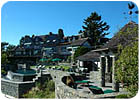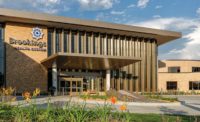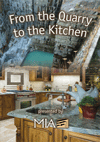
Originally built in 1901, the Wildacre residence located at Price's Neck Cove in Newport, RI, sits on 3.5 acres of land surrounded by natural granite outcroppings. The home underwent a restoration program headed by Madison Spencer Architects of Charlottesville, VA, which included the restoration of all stonework present.
Located on 3.5 acres of granite outcroppings at the mouth of Price's Neck Cove in Newport, RI, sits the Wildacre residence - one of the many early 20th century cottages that constituted the summer residences of the fashionable set in preservation in the area. Originally constructed in 1901, Wildacre, named for its wild oceanfront site, was the summer estate of the Hartford banker Albert H. Olmsted; step-brother of the famed landscape architect Frederick Law Olmsted - designer of Central Park in New York City. The Olmsted Brothers firm conceived the idea for the grounds and collaborated with architect Irving Gill on the design.
The estate abuts Ocean Avenue, along with several of Newport's historic homes, and encompasses a rock ridge bridging two points jutting out into the Atlantic Ocean. Dorrance Hamilton - a dedicated preservationist - purchased the 8,000-square-foot residence in the fall of 1998, and Madison Spencer Architects office of Charlottesville, VA, and Newport, RI, was brought on board to serve as the architect and
advisor to the owner in the restoration and expansion of this property. All of the rough stone used for the project was taken out of the farm fields in Rhode Island, if not from the property itself.
Structural matters, including a sagging roof, were necessary to repair during the renovation. In addition, improvements were made to convert the home into a year-round residence, and according to Architect Madison Spencer, the existing stonework had visibly deteriorated over the years.
The architect said that the focus of the renovation was to keep the original integrity of the residence. “Our goal was to make responsible use of the materials before us and abide by the original design intent of the Olmsted brothers and Irving Gill,†he said. “We wanted to approach this project in such a way that it would seem as if the house remained as it was. You know our job has been done well when the casual observer believes it is work of 100 years ago.â€
A Portuguese stonemason selected stone materials from Newport in order to match the original character of the house. “The Olmsteds were naturalists in terms of how they envisioned their [property],†said Spencer. “Our tendency is to look at the cultural characteristics of a region, and work with what's there to match that region. Architecturally, it's how you unite a structure with its environment, by using characteristics that you literally find at your feet, and we had the advantage of Anthony Pettitas, master mason, to direct the effort.â€
The architect added that there is a seamless vein of stones running through the landscape and the house to merge them together. Bluestone, granite and Greenstone are featured throughout the residence for the fireplace, flooring, mudrooms and the porch, which has stone walls that carry through from the foundation. “The wall stone is hard to work with and fractures wildly, but at the same time it suits the house,†said Spencer.
The swimming pool - built where the original Olmsted salt pools stood - and grounds were restored using original plans and drawings, while the new pavilions were intended to keep to the original subtle “Asian theme†intended by the Olmsteds and Gill. “They are all made from the local stone and timber,†said Spencer. “Some of the stone we used was debris we secured from blasting we had to do in order to situate the structures.
“The only challenge we had was developing an understanding of how to work with the scale of rock we were finding,†the architect continued. “It was difficult finding clefts that would enable us to crack a rock. The rocks we found dictated to some extent how we used it. We couldn't really change the shape much, so we had to work with what was there.â€
Restoring the Stone
BR Arnold Construction Co. of Newport, RI, was in charge of the installation and restoration of the stonework for the Wildacre residence. According to Brian Arnold, the stone was in very poor condition when his crew began working. “Over the years, the stone had kind of been dislodged by poor weather,†he said. “The rain and movement in the winter slowly broke it down. We pretty much had to restore all of the stone on the house, and the chimneys were repointed.â€Arnold said that miraculously - given the immensity of the project, which involved 228 tons of stone - the restoration took a mere 18 months to complete with an average of 22 workers a day on site.
“It was difficult to match the detail of the stone to the period of the home,†he said, adding that a lot of patience was key to the success of the project. “A lot of craftsmanship constructed these walls and terraces.†Arnold added that the cliffside location of the residence also posed challenges for the crew, but that everyone is thrilled at its outcome.
Spencer agreed that the project was complex, but for different reasons. He said that the restoration was tricky because of the Newport historic district community's concern for how historic projects are maintained. In addition, the Coastal Resource Management Council - an agency that holds sway along the Eastern seaboard - was afraid that the residence would literally fall into the ocean.
“Luckily, the organizations understood our vision,†said the architect. “Now, Wildacre is another jewel in the crown of properties in Newport. It has received several preservation awards and is shown on historic and garden tours.†The Newport Historical Society proudly named Wildacre the recipient of its Historic Preservation Award.


